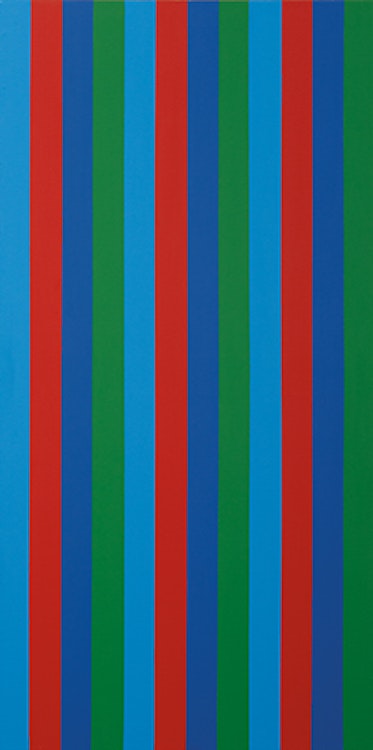Tri-sériel rouge by Guido Molinari

Guido Molinari
Tri-sériel rouge
acrylic on canvas
signed and dated 1964 on the reverse
46.75 x 23.5 ins ( 118.7 x 59.7 cms )
Auction Estimate: $70,000.00 - $90,000.00
Price Realized $82,600.00
Sale date: September 24th 2020
Galerie Camille Hébert, Montreal
Private Collection, Montreal
Josée Bélisle, “Art that is Said to Represent Nothing ...” in La Question de l’abstraction, Montréal, Musée d'art contemporain, 2013, pages 58-78 for a more detailed orientation to the Montréal School of abstraction
Fulvio Caccia, Interviews with the Phoenix: Interviews with Fifteen Italian-Quebecois Artists, translated by Daniel Sloate, Toronto, 1998, pages 48-49
Molinari has claimed that “space is essentially energy.” Tri-sériel rouge constructs a three-dimensional atmosphere through the viewer’s apprehension of the components underlined by its succinct title: seriality and colour. Seriality arises from the four colour bands or stripes that we typically read from left to right: light blue, red, dark blue, green. Each sequence is repeated three times. Our perceptual makeup has us see the red first, apparently moving out towards us. The exact repetition of this succession ensures that our eyes and minds do not rest on one element; we are constantly remaking this painting. As we contemplate this surface, however, it’s also clear that each colour repeats three times. We can find other groupings of three in the painting, but we have no reason to give any one priority. With this dynamic effect, Molinari overcame what he saw as the limitations of a fixed, Euclidean geometry, a mere receptacle for colour and form. Instead, these formal elements collaborate with the artist and viewer to convey a ceaseless energy.
Molinari’s own organizational principle for stripe paintings such as Tri-sériel rouge was the structure of avant-garde music. Influenced by Webern and Schönberg, he consciously sought “to establish an interconnection in terms of three moments of the series: the beginning, the middle, and the end.” Molinari was also compelled by the earlier 20th-century abstraction of Mondrian especially, which he saw in New York. Like Mondrian, he used music as an exemplary structuring form, a ‘language’ largely removed from the fetters of the spoken and written word that also compelled both artists. Molinari is important in the long and vibrant history of abstract art because of these historical affinities and thanks to the ever-present energy of a painting such as Tri-sériel rouge.
We thank Dr. Mark A. Cheetham, professor of art history at the University of Toronto and author of Abstract Art Against Autonomy: Infection, Resistance, and Cure since the '60s (Cambridge University Press), for contributing the preceding essay.
Share this item with your friends
Guido Molinari
(1933 - 2004) Les Plasticiens
Guido Molinari was born in Montreal in 1933. He studied briefly at the School of Design at the Montreal Museum of Fine Arts (1950-51), and began making drawings and paintings combining automatic methods with a disciplined approach. He was a leader in the development of a rigorous colour abstraction movement in Montreal. Characteristic of his paintings in the 1960s were vertical, hard-edged bands of colour. Pictorial space in these paintings was created by the spectator’s perception of the shifting and mixing of colours.
In 1956 Molinari was a founding member of the Association des Artistes Non-Figuratifs de Montreal. He exhibited at the Biennale in Venice in 1968, where he was awarded the David E. Bright Foundation prize. In 1977 he participated in the Paris Biennale, and in 1980 he was awarded the Paul-Emile Borduas Prize by the Quebec government. Molinari, who taught at Concordia University until 1997, exerted a powerful influence on younger artists, through his teaching, his theoretical writing and his opinions, firmly held and strongly stated.

